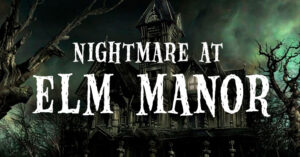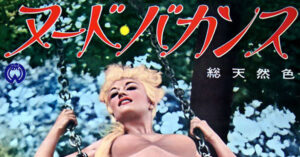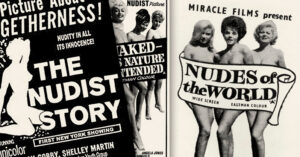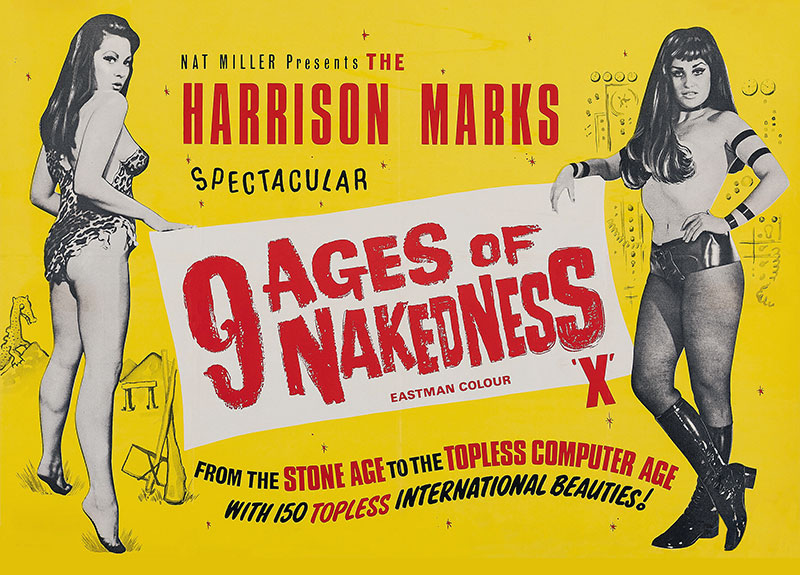
I can’t believe that in all the years I’ve been running this blog this is the first post I’ve written on the feature film The Nine Ages of Nakedness. A film that the director George Harrison Marks boasted featured “150 girls in the all-together”.
It was originally entitled The Seven Ages of Nakedness, a title inspired by John Gielgud’s one-man show The Seven Ages of Man, but to increase the film’s running time to a reasonable length two more ages had to be added. Even with the two extra ages, the whole film seems a bit stretched.
In the film, George Harrison Marks plays a rather camp glamour photographer whose encounters with women are bedevilled by mishaps. This leads him to seek help from an “Indian” psycho-analyst with a comedy accent on Harley Street. While on the couch, he declares his belief that the male members of his family are cursed and recounts nine tales of family misfortune.
The Nine Ages of Nakedness
THE STONE AGE. ‘Harry Stone Marks’, fresh from carving Stonehenge is employed to draw a cavewoman housewife (June Palmer), only to end up pelted with rocks when her husband takes a fancy to Marks’ blonde secretary. I love the stone age record player in this scene — very Flintstones.
THE EGYPTIAN AGE. The Jewish slave ‘Harrison Hubergritz’ is commissioned to design a burial chamber for the Pharaoh. He employs six beautiful girls as models, but as the project will take him a lifetime to complete, he replaces them as time lessens their loveliness. After fifty years a misplaced hammer blow causes the whole edifice to collapse.
THE CHINESE AGE. In an oriental offshoot of the Marks family, Ha-Ri-Son, a wealthy and elderly Mandarin gentleman who worships his lovely young wife, becomes enraged when he finds her in the arms of his gardener. Seeing them passionately embracing on a bridge he uses his mystical powers to turn the whole garden including the lovers, into blue and white porcelain — thus was born the legend of the willow pattern.
THE GRECIAN AGE. The ageing Professor Marc, sculptor, wanders through a tree-lined avenue of stone plinths and on all except one stands a lovely nude woman. As he gazes at the empty plinth, the professor recalls the captivating model with whom he once fell in love with.
THE CAVALIER AGE. Sir Harrison Chandelier is hired by Sir Rupert to paint a nude portrait of Her Ladyship. Totally focussed on his work he fails to notice the arrival of The Roundheads. Cromwell’s men slash the canvas to ribbons, and Sir Harrison is committed to the stocks and pelted with refuse, and subjected to the insults of the mob. This is a semi-remake of one of Marks earlier 8mm glamour films called The Bare Truth.
THE OLD TIME MUSIC HALL AGE. In Victorian England, music hall impresario ‘The Great Marko’, is down on his luck. A chance meeting with a Cockney cleaning lady — who he imagines topless — provides Marko with the idea of presenting a show based around ‘Living Statues’. This leads him to be prosecuted, but the court merely imposes a small fine as the judge is appreciative of the art form.
THE OLD DARK HOUSE. This scene was missing from the cut of the film I have on DVD. All I know about it is that it features “Professor Frankenstein Harrison Marks”.
THE POETIC AGE. Byron Marks waxes lyrically about women but fails to get any credit for his poetry.
THE TOPLESS COMPUTER AGE. It is approaching the year 3000, and a group of gorgeous topless beauties attend a maze of computers. Their leader (Monique Devereaux), escorting visitors from another planet, shows them the only male they keep in captivity to populate the sphere. Caveman like, he gnaws a bone, whilst on a wall is kept the score of his hundreds of conquests. This is the only story in which Marks does not make a cameo appearance.
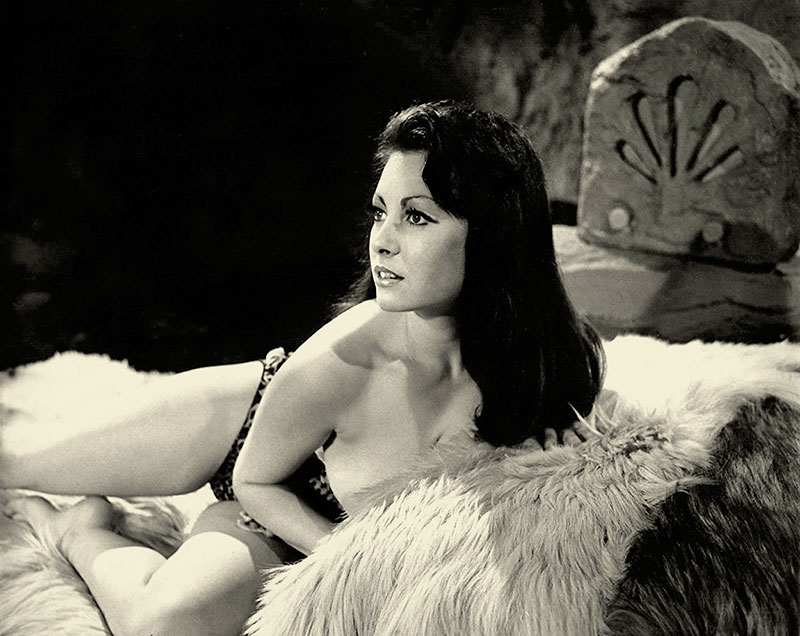
Not long after he completed the film, Marks declared bankruptcy and sold all rights to it. Who the current rights owner are unknown but I have heard a rumour that several cans of film labelled The Nine Ages of Nakedness lurk in the basement of the BFI collecting dust. As I said, the version I have on DVD omits the “Old Dark House” story, even though it lists it on the back cover copy. In addition, it seems footage from the “Computer Age” sequence was also deleted, including the punch line. Maybe one day a decent cut of the film will emerge.
